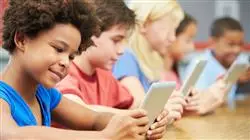University certificate
Scientific endorser

The world's largest faculty of education”
Introduction to the Program
A comprehensive and 100% online program, exclusive to TECH, with an international perspective backed by our membership in the Association for Teacher Education in Europe"

The evolution of the educational model has led teaching professionals to rethink their pedagogical strategies, incorporating active methodologies that foster student participation and enhance their learning process. Among these, Flipped Classroom has proven to be one of the most effective, as it moves part of the theoretical content outside the classroom to make room for dynamic and collaborative activities during class time. In fact, a UNESCO report reveals that the application of innovative approaches improves knowledge retention and strengthens critical thinking, which are essential skills in today’s education.
In response, TECH Global University introduces an innovative Masters Degree in Flipped Classroom. The academic journey will delve into aspects ranging from the personalization of teaching and cooperative patterns for a Flipped Classroom, to the creation of original content to enhance the classroom experience. As a result, graduates will develop advanced competencies to transform their teaching practice, designing active, flexible, and student-centered learning experiences.
Thanks to the flexibility of this academic program, graduates will be able to access the content at any time and from any device with internet access, ensuring a continuous and updated learning experience. Moreover, teachers seeking to update their knowledge will benefit from the Relearning method, a TECH Global University pioneering learning model that guarantees effective knowledge assimilation at their own pace.
Furthermore, thanks to TECH's membership in the Association for Teacher Education in Europe (ATEE), professionals will have access to specialized academic journals and discounts on publications. They will also be able to attend webinars or conferences at no cost and receive linguistic support. Additionally, they will be included in the ATEE consultancy database, thereby expanding their professional network and gaining access to new opportunities.
You will apply learning personalization strategies, tailored to different educational levels and student profiles”
This Masters Degree in Flipped Classroom contains the most complete and up-to-date educational program on the market. The most important features include:
- Practical cases presented by experts in Flipped Classroom
- The graphic, schematic, and practical contents with which they are created, provide scientific and practical information on the disciplines that are essential for professional practice
- Practical exercises where the self-assessment process can be carried out to improve learning
- Special emphasis on innovative methodologies in Flipped Classroom
- Theoretical lessons, questions to the expert, debate forums on controversial topics, and individual reflection assignments
- Content that is accessible from any fixed or portable device with an Internet connection
With the Relearning system, you will not need to invest excessive hours in study and will focus on the most relevant concepts”
The program includes faculty members from the Flipped Classroom field, who bring their professional experience to this program, alongside recognized specialists from leading societies and prestigious universities.
Its multimedia content, developed with the latest educational technology, will provide professionals with situated and contextualized learning—meaning a simulated environment that offers immersive study, preparing you to face real-world situations.
This program is designed around Problem-Based Learning, whereby the student must try to solve the different professional practice situations that arise throughout the program. For this purpose, the professional will be assisted by an innovative interactive video system created by renowned and experienced experts.
You will master digital tools for the creation of educational content, platform management, and evaluation"

You will promote collaborative work and critical thinking, integrating the Flipped Classroom with other active methodologies"
Why study at TECH?
TECH is the world’s largest online university. With an impressive catalog of more than 14,000 university programs available in 11 languages, it is positioned as a leader in employability, with a 99% job placement rate. In addition, it relies on an enormous faculty of more than 6,000 professors of the highest international renown.

Study at the world's largest online university and guarantee your professional success. The future starts at TECH”
The world’s best online university according to FORBES
The prestigious Forbes magazine, specialized in business and finance, has highlighted TECH as “the world's best online university” This is what they have recently stated in an article in their digital edition in which they echo the success story of this institution, “thanks to the academic offer it provides, the selection of its teaching staff, and an innovative learning method aimed at educating the professionals of the future”
A revolutionary study method, a cutting-edge faculty and a practical focus: the key to TECH's success.
The most complete study plans on the university scene
TECH offers the most complete study plans on the university scene, with syllabuses that cover fundamental concepts and, at the same time, the main scientific advances in their specific scientific areas. In addition, these programs are continuously being updated to guarantee students the academic vanguard and the most in-demand professional skills. In this way, the university's qualifications provide its graduates with a significant advantage to propel their careers to success.
TECH offers the most comprehensive and intensive study plans on the current university scene.
A world-class teaching staff
TECH's teaching staff is made up of more than 6,000 professors with the highest international recognition. Professors, researchers and top executives of multinational companies, including Isaiah Covington, performance coach of the Boston Celtics; Magda Romanska, principal investigator at Harvard MetaLAB; Ignacio Wistumba, chairman of the department of translational molecular pathology at MD Anderson Cancer Center; and D.W. Pine, creative director of TIME magazine, among others.
Internationally renowned experts, specialized in different branches of Health, Technology, Communication and Business, form part of the TECH faculty.
A unique learning method
TECH is the first university to use Relearning in all its programs. It is the best online learning methodology, accredited with international teaching quality certifications, provided by prestigious educational agencies. In addition, this disruptive educational model is complemented with the “Case Method”, thereby setting up a unique online teaching strategy. Innovative teaching resources are also implemented, including detailed videos, infographics and interactive summaries.
TECH combines Relearning and the Case Method in all its university programs to guarantee excellent theoretical and practical learning, studying whenever and wherever you want.
The world's largest online university
TECH is the world’s largest online university. We are the largest educational institution, with the best and widest online educational catalog, one hundred percent online and covering the vast majority of areas of knowledge. We offer a large selection of our own degrees and accredited online undergraduate and postgraduate degrees. In total, more than 14,000 university degrees, in eleven different languages, make us the largest educational largest in the world.
TECH has the world's most extensive catalog of academic and official programs, available in more than 11 languages.
Google Premier Partner
The American technology giant has awarded TECH the Google Google Premier Partner badge. This award, which is only available to 3% of the world's companies, highlights the efficient, flexible and tailored experience that this university provides to students. The recognition as a Google Premier Partner not only accredits the maximum rigor, performance and investment in TECH's digital infrastructures, but also places this university as one of the world's leading technology companies.
Google has positioned TECH in the top 3% of the world's most important technology companies by awarding it its Google Premier Partner badge.
The official online university of the NBA
TECH is the official online university of the NBA. Thanks to our agreement with the biggest league in basketball, we offer our students exclusive university programs, as well as a wide variety of educational resources focused on the business of the league and other areas of the sports industry. Each program is made up of a uniquely designed syllabus and features exceptional guest hosts: professionals with a distinguished sports background who will offer their expertise on the most relevant topics.
TECH has been selected by the NBA, the world's top basketball league, as its official online university.
The top-rated university by its students
Students have positioned TECH as the world's top-rated university on the main review websites, with a highest rating of 4.9 out of 5, obtained from more than 1,000 reviews. These results consolidate TECH as the benchmark university institution at an international level, reflecting the excellence and positive impact of its educational model.” reflecting the excellence and positive impact of its educational model.”
TECH is the world’s top-rated university by its students.
Leaders in employability
TECH has managed to become the leading university in employability. 99% of its students obtain jobs in the academic field they have studied, within one year of completing any of the university's programs. A similar number achieve immediate career enhancement. All this thanks to a study methodology that bases its effectiveness on the acquisition of practical skills, which are absolutely necessary for professional development.
99% of TECH graduates find a job within a year of completing their studies.
Master's Degree in Flipped Classroom
The Master's Degree in Flipped Classroom designed by TECH Global University will develop digital competencies for teaching professionals, enabling them to implement teamwork, address student diversity with a specialized approach, and enhance organization, programming, management, and evaluation of objectives and teaching-learning processes through the model presented in this program, also known as the flipped classroom. The goal is to improve, increase, and optimize classroom work time using active methodologies. This program is developed over the course of one year and consists of ten modules, which explore the concept of the model, its initiation, along with new cooperative learning techniques, the development of a flipped classroom, content creation and tools for it, gamification, escape rooms in classrooms, graphic material creation that goes beyond video, programming and planning, among other topics.
Study an online Master's Degree in flipped classroom methodology
This syllabus can be completed through an e-learning teaching method, which is entirely asynchronous and offers offline content, allowing access from any digital device such as a computer, tablet, or smartphone, offering flexibility in both location and schedule when developing the course material. The content structure has been designed by a team of professionals from the best educational institutions and universities in the country, aware of the importance of innovative education and committed to high-quality teaching through new educational technologies. The instructional elements will enable the development of practical cases, theoretical lessons, and discussion forums. This methodology will help students understand and solve critical situations creatively, efficiently, and in line with what has been learned throughout the academic program. Finally, students will have access to all study materials, interactive summaries, masterclasses, complementary readings, and a methodology designed to help retain long-term learning.







